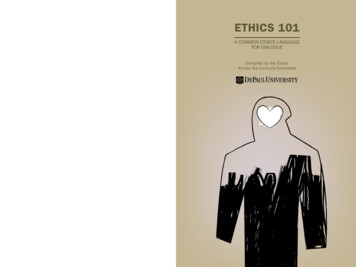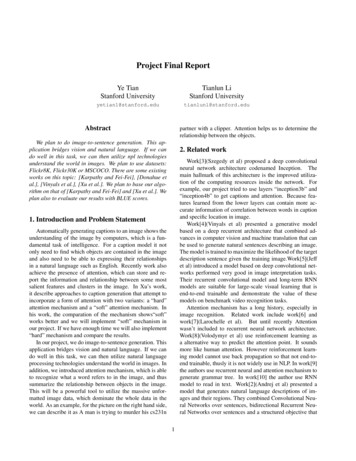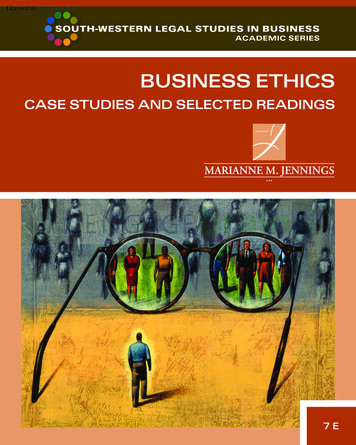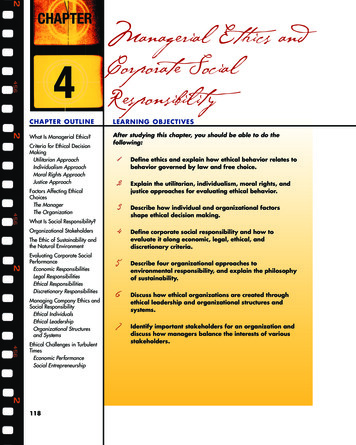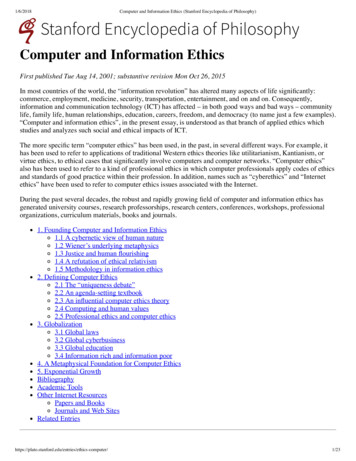
Transcription
1/6/2018Computer and Information Ethics (Stanford Encyclopedia of Philosophy)Stanford Encyclopedia of PhilosophyComputer and Information EthicsFirst published Tue Aug 14, 2001; substantive revision Mon Oct 26, 2015In most countries of the world, the “information revolution” has altered many aspects of life significantly:commerce, employment, medicine, security, transportation, entertainment, and on and on. Consequently,information and communication technology (ICT) has affected – in both good ways and bad ways – communitylife, family life, human relationships, education, careers, freedom, and democracy (to name just a few examples).“Computer and information ethics”, in the present essay, is understood as that branch of applied ethics whichstudies and analyzes such social and ethical impacts of ICT.The more specific term “computer ethics” has been used, in the past, in several different ways. For example, ithas been used to refer to applications of traditional Western ethics theories like utilitarianism, Kantianism, orvirtue ethics, to ethical cases that significantly involve computers and computer networks. “Computer ethics”also has been used to refer to a kind of professional ethics in which computer professionals apply codes of ethicsand standards of good practice within their profession. In addition, names such as “cyberethics” and “Internetethics” have been used to refer to computer ethics issues associated with the Internet.During the past several decades, the robust and rapidly growing field of computer and information ethics hasgenerated university courses, research professorships, research centers, conferences, workshops, professionalorganizations, curriculum materials, books and journals.1. Founding Computer and Information Ethics1.1 A cybernetic view of human nature1.2 Wiener’s underlying metaphysics1.3 Justice and human flourishing1.4 A refutation of ethical relativism1.5 Methodology in information ethics2. Defining Computer Ethics2.1 The “uniqueness debate”2.2 An agenda-setting textbook2.3 An influential computer ethics theory2.4 Computing and human values2.5 Professional ethics and computer ethics3. Globalization3.1 Global laws3.2 Global cyberbusiness3.3 Global education3.4 Information rich and information poor4. A Metaphysical Foundation for Computer Ethics5. Exponential GrowthBibliographyAcademic ToolsOther Internet ResourcesPapers and BooksJournals and Web SitesRelated omputer/1/23
1/6/2018Computer and Information Ethics (Stanford Encyclopedia of Philosophy)1. Founding Computer and Information EthicsIn the mid 1940s, innovative developments in science and philosophy led to the creation of a new branch ofethics that would later be called “computer ethics” or “information ethics”. The founder of this newphilosophical field was the American scholar Norbert Wiener, a professor of mathematics and engineering atMIT. During the Second World War, together with colleagues in America and Great Britain, Wiener helped todevelop electronic computers and other new and powerful information technologies. While engaged in this wareffort, Wiener and colleagues created a new branch of applied science that Wiener named “cybernetics” (fromthe Greek word for the pilot of a ship). Even while the War was raging, Wiener foresaw enormous social andethical implications of cybernetics combined with electronic computers. He predicted that, after the War, theworld would undergo “a second industrial revolution” – an “automatic age” with “enormous potential for goodand for evil” that would generate a staggering number of new ethical challenges and opportunities.When the War ended, Wiener wrote the book Cybernetics (1948) in which he described his new branch ofapplied science and identified some social and ethical implications of electronic computers. Two years later hepublished The Human Use of Human Beings (1950), a book in which he explored a number of ethical issues thatcomputer and information technology would likely generate. The issues that he identified in those two books,plus his later book God and Golem, Inc. (1963), included topics that are still important today: computers andsecurity, computers and unemployment, responsibilities of computer professionals, computers for persons withdisabilities, information networks and globalization, virtual communities, teleworking, merging of human bodieswith machines, robot ethics, artificial intelligence, computers and religion, and a number of other subjects. (SeeBynum 2000, 2004, 2005, 2008a, 2008b.)Although he coined the name “cybernetics” for his new science, Wiener apparently did not see himself as alsocreating a new branch of ethics. As a result, he did not coin a name like “computer ethics” or “informationethics”. These terms came into use decades later. (See the discussion below.) In spite of this, Wiener’s threerelevant books (1948, 1950, 1963) do lay down a powerful foundation, and do use an effective methodology, fortoday’s field of computer and information ethics. His thinking, however, was far ahead of other scholars; and, atthe time, many people considered him to be an eccentric scientist who was engaging in flights of fantasy aboutethics. Apparently, no one – not even Wiener himself – recognized the profound importance of his ethicsachievements; and nearly two decades would pass before some of the social and ethical impacts of informationtechnology, which Wiener had predicted in the late 1940s, would become obvious to other scholars and to thegeneral public.In The Human Use of Human Beings, Wiener explored some likely effects of information technology upon keyhuman values like life, health, happiness, abilities, knowledge, freedom, security, and opportunities. Themetaphysical ideas and analytical methods that he employed were so powerful and wide-ranging that they couldbe used effectively for identifying, analyzing and resolving social and ethical problems associated with all kindsof information technology, including, for example, computers and computer networks; radio, television andtelephones; news media and journalism; even books and libraries. Because of the breadth of Wiener’s concernsand the applicability of his ideas and methods to every kind of information technology, the term “informationethics” is an apt name for the new field of ethics that he founded. As a result, the term “computer ethics”, as it istypically used today, names only a subfield of Wiener’s much broader concerns.In laying down a foundation for information ethics, Wiener developed a cybernetic view of human nature andsociety, which led him to an ethically suggestive account of the purpose of a human life. Based upon this, headopted “great principles of justice”, which he believed all societies ought to follow. These powerful ethicalconcepts enabled Wiener to analyze information ethics issues of all kinds.1.1 A cybernetic view of human natureWiener’s cybernetic understanding of human nature stressed the physical structure of the human body and theremarkable potential for learning and creativity that human physiology makes possible. While explaining puter/2/23
1/6/2018Computer and Information Ethics (Stanford Encyclopedia of Philosophy)intellectual potential, he regularly compared the human body to the physiology of less intelligent creatures likeinsects:Cybernetics takes the view that the structure of the machine or of the organism is an index of theperformance that may be expected from it. The fact that the mechanical rigidity of the insect is suchas to limit its intelligence while the mechanical fluidity of the human being provides for his almostindefinite intellectual expansion is highly relevant to the point of view of this book. man’sadvantage over the rest of nature is that he has the physiological and hence the intellectualequipment to adapt himself to radical changes in his environment. The human species is strong onlyinsofar as it takes advantage of the innate, adaptive, learning faculties that its physiological structuremakes possible. (Wiener 1954, pp. 57–58, italics in the original)Given the physiology of human beings, it is possible for them to take in a wide diversity of information from theexternal world, access information about conditions and events within their own bodies, and process all thatinformation in ways that constitute reasoning, calculating, wondering, deliberating, deciding and many otherintellectual activities. Wiener concluded that the purpose of a human life is to flourish as the kind of informationprocessing organisms that humans naturally are:I wish to show that the human individual, capable of vast learning and study, which may occupyalmost half of his life, is physically equipped, as the ant is not, for this capacity. Variety andpossibility are inherent in the human sensorium – and are indeed the key to man’s most noble flights– because variety and possibility belong to the very structure of the human organism. (Wiener 1954,pp. 51–52)1.2 Wiener’s underlying metaphysicsWiener’s account of human nature presupposed a metaphysical view of the universe that considers the world andall the entities within it, including humans, to be combinations of matter-energy and information. Everything inthe world is a mixture of both of these, and thinking, according to Wiener, is actually a kind of informationprocessing. Consequently, the braindoes not secrete thought “as the liver does bile”, as the earlier materialists claimed, nor does it put itout in the form of energy, as the muscle puts out its activity. Information is information, not matteror energy. No materialism which does not admit this can survive at the present day. (Wiener 1948, p.155)According to Wiener’s metaphysical view, everything in the universe comes into existence, persists, and thendisappears because of the continuous mixing and mingling of information and matter-energy. Living organisms,including human beings, are actually patterns of information that persist through an ongoing exchange of matterenergy. Thus, he says of human beings,We are but whirlpools in a river of ever-flowing water. We are not stuff that abides, but patterns thatperpetuate themselves. (Wiener 1954, p. 96) The individuality of the body is that of a flame of a form rather than of a bit of substance. (Wiener1954, p. 102)Using the language of today’s “information age” (see, for example, Lloyd 2006 and Vedral 2010) we would saythat, according to Wiener, human beings are “information objects”; and their intellectual capacities, as well astheir personal identities, are dependent upon persisting patterns of information and information processingwithin the body, rather than on specific bits of thics-computer/3/23
1/6/2018Computer and Information Ethics (Stanford Encyclopedia of Philosophy)1.3 Justice and human flourishingAccording to Wiener, for human beings to flourish they must be free to engage in creative and flexible actionsand thereby maximize their full potential as intelligent, decision-making beings in charge of their own lives. Thisis the purpose of a human life. Because people have various levels and kinds of talent and possibility, however,one person’s achievements will be different from those of others. It is possible, nevertheless, to lead a goodhuman life – to flourish – in an indefinitely large number of ways; for example, as a diplomat, scientist, teacher,nurse, doctor, soldier, housewife, midwife, musician, tradesman, artisan, and so on.This understanding of the purpose of a human life led Wiener to adopt what he called “great principles ofjustice” upon which society should be built. He believed that adherence to those principles by a society wouldmaximize a person’s ability to flourish through variety and flexibility of human action. Although Wiener statedhis “great principles”, he did not assign names to them. For purposes of easy reference, let us call them “ThePrinciple of Freedom”, “The Principle of Equality” and “The Principle of Benevolence”. Using Wiener’s ownwords yields the following list of “great principles” (1954, pp. 105–106):The Principle of FreedomJustice requires “the liberty of each human being to develop in his freedom the full measure of the humanpossibilities embodied in him.”The Principle of EqualityJustice requires “the equality by which what is just for A and B remains just when the positions of A and Bare interchanged.”The Principle of BenevolenceJustice requires “a good will between man and man that knows no limits short of those of humanity itself.”Given Wiener’s cybernetic account of human nature and society, it follows that people are fundamentally socialbeings, and that they can reach their full potential only when they are part of a community of similar beings.Society, therefore, is essential to a good human life. Despotic societies, however, actually stifle human freedom;and indeed they violate all three of the “great principles of justice”. For this reason, Wiener explicitly adopted afourth principle of justice to assure that the first three would not be violated. Let us call this additional principle“The Principle of Minimum Infringement of Freedom”:The Principle of Minimum Infringement of Freedom“What compulsion the very existence of the community and the state may demand must be exercised in such away as to produce no unnecessary infringement of freedom” (1954, p. 106).1.4 A refutation of ethical relativismIf one grants Wiener’s account of a good society and of human nature, it follows that a wide diversity of cultures– with different customs, languages, religions, values and practices – could provide a context in which humanscan flourish. Sometimes ethical relativists use the existence of different cultures as proof that there is not – andcould not be – an underlying ethical foundation for societies all around the globe. In response to such relativism,Wiener could argue that, given his understanding of human nature and the purpose of a human life, we canembrace and welcome a rich variety of cultures and practices while still advocating adherence to “the greatprinciples of justice”. Those principles offer a cross-cultural foundation for ethics, even though they leave roomfor immense cultural diversity. The one restriction that Wiener would require in any society is that it mustprovide a context where humans can realize their full potential as sophisticated information-processing agents,making decisions and choices, and thereby taking responsibility for their own lives. Wiener believed that this ispossible only where significant freedom, equality and human compassion prevail.1.5 Methodology in information mputer/4/23
1/6/2018Computer and Information Ethics (Stanford Encyclopedia of Philosophy)Because Wiener did not think of himself as creating a new branch of ethics, he did not providemetaphilosophical comments about what he was doing while analyzing an information ethics issue or case.Instead, he plunged directly into his analyses. Consequently, if we want to know about Wiener’s method ofanalysis, we need to observe what he does, rather than look for any metaphilosophical commentary upon his ownprocedures.When observing Wiener’s way of analyzing information ethics issues and trying to resolve them, we find – forexample, in The Human Use of Human Beings – that he tries to assimilate new cases by applying alreadyexisting, ethically acceptable laws, rules, and practices. In any given society, there is a network of existingpractices, laws, rules and principles that govern human behavior within that society. These “policies” – toborrow a helpful word from Moor (1985) – constitute a “received policy cluster” (see Bynum and Schubert1997); and in a reasonably just society, they can serve as a good starting point for developing an answer to anyinformation ethics question. Wiener’s methodology is to combine the “received policy cluster” of one’s societywith Wiener’s account of human nature, plus his “great principles of justice”, plus critical skills in clarifyingvague or ambiguous language. In this way, he achieved a very effective method for analyzing information ethicsissues. Borrowing from Moor’s later, and very apt, description of computer ethics methodology (Moor 1985), wecan describe Wiener’s methodology as follows:1. Identify an ethical question or case regarding the integration of information technology into society.Typically this focuses upon technology-generated possibilities that could affect (or are already affecting)life, health, security, happiness, freedom, knowledge, opportunities, or other key human values.2. Clarify any ambiguous or vague ideas or principles that may apply to the case or the issue in question.3. If possible, apply already existing, ethically acceptable principles, laws, rules, and practices (the “receivedpolicy cluster”) that govern human behavior in the given society.4. If ethically acceptable precedents, traditions and policies are insufficient to settle the question or deal withthe case, use the purpose of a human life plus the great principles of justice to find a solution that fits aswell as possible into the ethical traditions of the given society.In an essentially just society – that is, in a society where the “received policy cluster” is reasonably just – thismethod of analyzing and resolving information ethics issues will likely result in ethically good solutions that canbe assimilated into the society.Note that this way of doing information ethics does not require the expertise of a trained philosopher (althoughsuch expertise might prove to be helpful in many situations). Any adult who functions successfully in areasonably just society is likely to be familiar with the existing customs, practices, rules and laws that govern aperson’s behavior in that society and enable one to tell whether a proposed action or policy would be accepted asethical. So those who must cope with the introduction of new information technology – whether they arecomputer professionals, business people, workers, teachers, parents, public-policy makers, or others – can andshould engage in information ethics by helping to integrate new information technology into society in anethically acceptable way. Information ethics, understood in this very broad sense, is too important to be left onlyto information professionals or to philosophers. Wiener’s information ethics interests, ideas and methods werevery broad, covering not only topics in the specific field of “computer ethics”, as we would call it today, but alsoissues in related areas that, today, are called “agent ethics” (see, for example, Floridi 2013b), “Internet ethics”(Cavalier 2005), and “nanotechnology ethics” (Weckert 2002). The purview of Wiener’s ideas and methods iseven broad enough to encompass subfields like journalism ethics, library ethics, and the ethics of bioengineering.Even in the late 1940s, Wiener made it clear that, on his view, the integration into society of the newly inventedcomputing and information technology would lead to the remaking of society – to “the second industrialrevolution” – “the automatic age”. It would affect every walk of life, and would be a multi-faceted, on-goingprocess requiring decades of effort. In Wiener’s own words, the new information technology had placed humanbeings “in the presence of another social potentiality of unheard-of importance for good and for evil.” (1948, p.27) However, because he did not think of himself as creating a new branch of ethics, Wiener did not coin names,such as “computer ethics” or “information ethics”, to describe what he was doing. These terms – beginning uter/5/23
1/6/2018Computer and Information Ethics (Stanford Encyclopedia of Philosophy)“computer ethics” – came into common use years later, starting in the mid 1970s with the work of Walter Maner.(see Maner 1980)Today, the “information age” that Wiener predicted more than half a century ago has come into existence; andthe metaphysical and scientific foundation for information ethics that he laid down continues to provide insightand effective guidance for understanding and resolving ethical challenges engendered by informationtechnologies of all kinds.2. Defining Computer EthicsIn 1976, nearly three decades after the publication of Wiener’s book Cybernetics, Walter Maner noticed that theethical questions and problems considered in his Medical Ethics course at Old Dominion University oftenbecame more complicated or significantly altered when computers got involved. Sometimes the addition ofcomputers, it seemed to Maner, actually generated wholly new ethics problems that would not have existed ifcomputers had not been invented. He concluded that there should be a new branch of applied ethics similar toalready existing fields like medical ethics and business ethics. After considering the name “information ethics”,he decided instead to call the proposed new field “computer ethics”.[1] (At that time, Maner did not know aboutthe computer ethics works of Norbert Wiener.) He defined the proposed new field as one that studies ethicalproblems “aggravated, transformed or created by computer technology”. He developed an experimentalcomputer ethics course designed primarily for students in university-level computer science programs. Hiscourse was a success, and students at his university wanted him to teach it regularly. He complied with theirwishes and also created, in 1978, a “starter kit” on teaching computer ethics, which he prepared fordissemination to attendees of workshops that he ran and speeches that he gave at philosophy conferences andcomputing science conferences in America. In 1980, Helvetia Press and the National Information and ResourceCenter on Teaching Philosophy published Maner’s computer ethics “starter kit” as a monograph (Maner 1980). Itcontained curriculum materials and pedagogical advice for university teachers. It also included a rationale foroffering such a course in a university, suggested course descriptions for university catalogs, a list of courseobjectives, teaching tips, and discussions of topics like privacy and confidentiality, computer crime, computerdecisions, technological dependence and professional codes of ethics. During the early 1980s, Maner’s StarterKit was widely disseminated by Helvetia Press to colleges and universities in America and elsewhere.Meanwhile Maner continued to conduct workshops and teach courses in computer ethics. As a result, a numberof scholars, especially philosophers and computer scientists, were introduced to computer ethics because ofManer’s trailblazing efforts.2.1 The “uniqueness debate”While Maner was developing his new computer ethics course in the mid-to-late 1970s, a colleague of his in thePhilosophy Department at Old Dominion University, Deborah Johnson, became interested in his proposed newfield. She was especially interested in Maner’s view that computers generate wholly new ethical problems, forshe did not believe that this was true. As a result, Maner and Johnson began discussing ethics cases thatallegedly involved new problems brought about by computers. In these discussions, Johnson granted thatcomputers did indeed transform old ethics problems in interesting and important ways – that is, “give them anew twist” – but she did not agree that computers generated ethically unique problems that had never been seenbefore. The resulting Maner-Johnson discussion initiated a fruitful series of comments and publications on thenature and uniqueness of computer ethics – a series of scholarly exchanges that started with Maner and Johnsonand later spread to other scholars. The following passage, from Maner’s ETHICOMP95 keynote address, drew anumber of other people into the discussion:I have tried to show that there are issues and problems that are unique to computer ethics. For all ofthese issues, there was an essential involvement of computing technology. Except for thistechnology, these issues would not have arisen, or would not have arisen in their highly alteredform. The failure to find satisfactory non-computer analogies testifies to the uniqueness of theseissues. The lack of an adequate analogy, in turn, has interesting moral consequences. -computer/6/23
1/6/2018Computer and Information Ethics (Stanford Encyclopedia of Philosophy)when we confront unfamiliar ethical problems, we use analogies to build conceptual bridges tosimilar situations we have encountered in the past. Then we try to transfer moral intuitions acrossthe bridge, from the analog case to our current situation. Lack of an effective analogy forces us todiscover new moral values, formulate new moral principles, develop new policies, and find newways to think about the issues presented to us. (Maner 1996, p. 152)Over the decade that followed the publication of this provocative passage, the extended “uniqueness debate” ledto a number of useful contributions to computer and information ethics. (For some example publications, seeJohnson 1985, 1994, 1999, 2001; Maner 1980, 1996, 1999; Gorniak-Kocikowska 1996; Tavani 2002, 2005;Himma 2003; Floridi and Sanders 2004; Mather 2005; and Bynum 2006, 2007.)2.2 An agenda-setting textbookBy the early 1980s, Johnson had joined the staff of Rensselaer Polytechnic Institute and had secured a grant toprepare a set of teaching materials – pedagogical modules concerning computer ethics – that turned out to bevery successful. She incorporated them into a textbook, Computer Ethics, which was published in 1985 (Johnson1985). On page 1, she noted that computers “pose new versions of standard moral problems and moraldilemmas, exacerbating the old problems, and forcing us to apply ordinary moral norms in uncharted realms.”She did not grant Maner’s claim, however, that computers create wholly new ethical problems. Instead, shedescribed computer ethics issues as old ethical problems that are “given a new twist” by computer technology.Johnson’s book Computer Ethics was the first major textbook in the field, and it quickly became the primary textused in computer ethics courses offered at universities in English-speaking countries. For more than a decade,her textbook set the computer ethics research agenda on topics, such as ownership of software and intellectualproperty, computing and privacy, responsibilities of computer professionals, and fair distribution of technologyand human power. In later editions (1994, 2001, 2009), Johnson added new ethical topics like “hacking” intopeople’s computers without their permission, computer technology for persons with disabilities, and ethics onthe Internet.Also in later editions of Computer Ethics, Johnson continued the “uniqueness-debate” discussion, noting forexample that new information technologies provide new ways to “instrument” human actions. Because of this,she agreed with Maner that new specific ethics questions had been generated by computer technology – forexample, “Should ownership of software be protected by law?” or “Do huge databases of personal informationthreaten privacy?” – but she argued that such questions are merely “new species of old moral issues”, such asprotection of human privacy or ownership of intellectual property. They are not, she insisted, wholly new ethicsproblems requiring additions to traditional ethical theories, as Maner had claimed (Maner 1996).2.3 An influential computer ethics theoryThe year 1985 was a “watershed year” in the history of computer ethics, not only because of the appearance ofJohnson’s agenda-setting textbook, but also because James Moor’s classic paper, “What Is Computer Ethics?”was published in a special computer-ethics issue of the journal Metaphilosophy. There Moor provided anaccount of the nature of computer ethics that was broader and more ambitious than the definitions of Maner orJohnson. He went beyond descriptions and examples of computer ethics problems by offering an explanation ofwhy computing technology raises so many ethical questions compared to other kinds of technology. Moor’sexplanation of the revolutionary power of computer technology was that computers are “logically malleable”:Computers are logically malleable in that they can be shaped and molded to do any activity that canbe characterized in terms of inputs, outputs and connecting logical operations . Because logicapplies everywhere, the potential applications of computer technology appear limitless. Thecomputer is the nearest thing we have to a universal tool. Indeed, the limits of computers are largelythe limits of our own creativity. (Moor, 1985, uter/7/23
1/6/2018Computer and Information Ethics (Stanford Encyclopedia of Philosophy)The logical malleability of computer technology, said Moor, makes it possible for people to do a vast number ofthings that they were not able to do before. Since no one could do them before, the question may never havearisen as to whether one ought to do them. In addition, because they could not be done before, perhaps no lawsor standards of good practice or specific ethical rules had ever been established to govern them. Moor calledsuch situations “policy vacuums”, and some of those vacuums might generate “conceptual muddles”:A typical problem in computer ethics arises because there is a policy vacuum about how computertechnology should be used. Computers provide us with new capabilities and these in turn give usnew choices for action. Often, either no policies for conduct in these situations exist or existingpolicies seem inadequate. A central task of computer ethics is to determine what we should do insuch cases, that is, formulate policies to guide our actions . One difficulty is that along with apolicy vacuum there is often a conceptual v
plus his later book God and Golem, Inc. (1963), included topics that are still important today: computers and security, computers and unemployment, responsibilities of computer professionals, computers for persons with disabilities, information networks and globalization, virtual communities, teleworking, merging of human bodies

